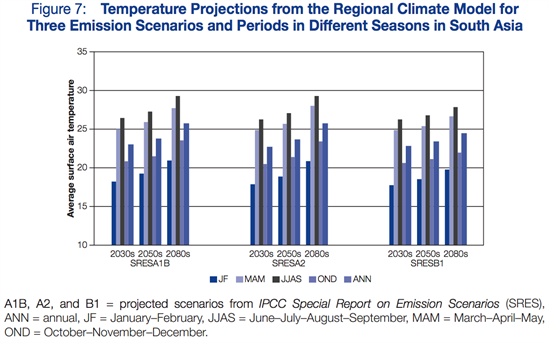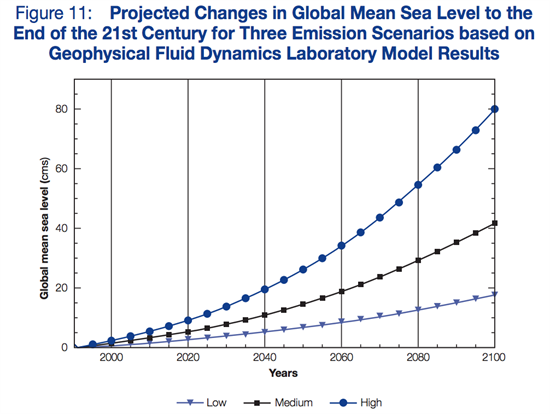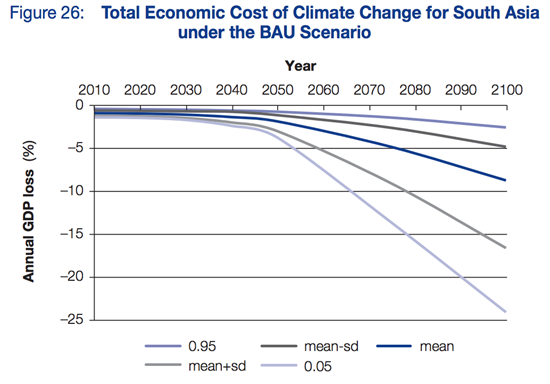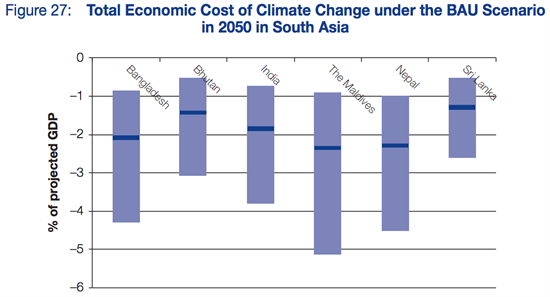Mat Hope
20.08.2014 | 3:50pmIndia, Sri Lanka, and Bangladesh will face “major challenges” as the impacts of climate change start to bite, according to a new report.
The Asian Development Bank’s (ADB) 163-page analysis outlines how warmer temperatures and rising seas could hit South Asia’s varied economies, home to nearly 1.5 billion people. It concludes that the “impacts of climate change are likely to result in huge economic, social and environmental damage to South Asian countries”.
Climate impacts
ADB uses the Intergovernmental Panel on Climate Change’s (IPCC) emissions scenarios to model potential climatic changes in South Asia between now and 2100. It then uses an economic model to estimate how the climate impacts may affect the region’s development.
The analysis was conducted prior to the release of the three instalments of the IPCC’s fifth assessment report – published between November 2013 and April this year – so uses data from the fourth report, released in 2007.
What does it show? For starters, the region is expected to get warmer. The region’s temperatures could rise two to five degrees above pre-industrial levels by 2100, ADB estimates.
The graph below shows the rate at which temperatures are expected to rise. The groups of bars are the different emissions pathways. The different coloured bars refer to temperature during particular months, initialled in the legend.
It shows that even if emissions are reduced at a more rapid rate – the bars in the right group – temperatures are expected to increase as the decades progress.
Rising temperatures are also likely to hit the region’s food crops, the analysis shows.
While yields may increase in some areas, India’s rice crops are likely to be severely hit. The graph below shows that in all but one of India’s regions, a temperature rise of one degree or more could result in yields reducing by up to 31 per cent:
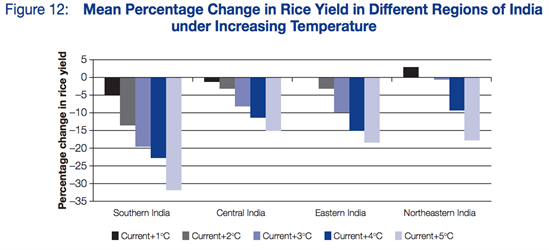
ADB’s analysis also shows sea levels are expected to rise. The region’s coasts could experience a rise of five to 25 centimetres between the 1990s and the 2050s, and 18 to 80 centimetres toward the end of the century, its modelling suggests.
The graph below shows the extent of the rise, depending on future emissions:
That could be a particular problem for the region’s coastal states – Bangladesh, India, the Maldives and Sri Lanka – the report says. Rising sea levels make flooding from tropical cyclones, storms and tsunamis more likely, it claims.
Economic impacts
Such physical changes could also hit South Asia’s economy, the report says.
Based on emissions consistent with a temperature rise of 4.6 degrees above pre-industrial levels by 2080, ADB estimates the region could lose the equivalent of 1.8 per cent of GDP annually by 2050. That could rise to 8.8 per cent in 2100, it says.
The graph below shows the potential economic impact of emissions continuing to rise at the same pace as today. The dark blue line shows the average economic impact, in terms of lost GDP per year:
In the worst case scenario, the region could lose 25 per cent of GDP annually by 2100, it shows.
But climate change is likely to affect each country’s economies differently. Poorer countries whose economies are largely dependent on agriculture are likely to be the worst hit, ADB says. The Maldives is likely to be worst hit in the middle of the century, followed by Nepal and Sri Lanka, as this graph shows:
But the economic impact of climate change can be constrained if global emissions are curbed.
ADB’s analysis suggests that if countries implement policies to curb global warming to two degrees above pre-industrial levels – the internationally agreed goal – the region could stand to lose around 2.5 per cent of GDP annually in 2100.
That’s still significant, but a lot less than if countries allow emissions to continue to climb.


